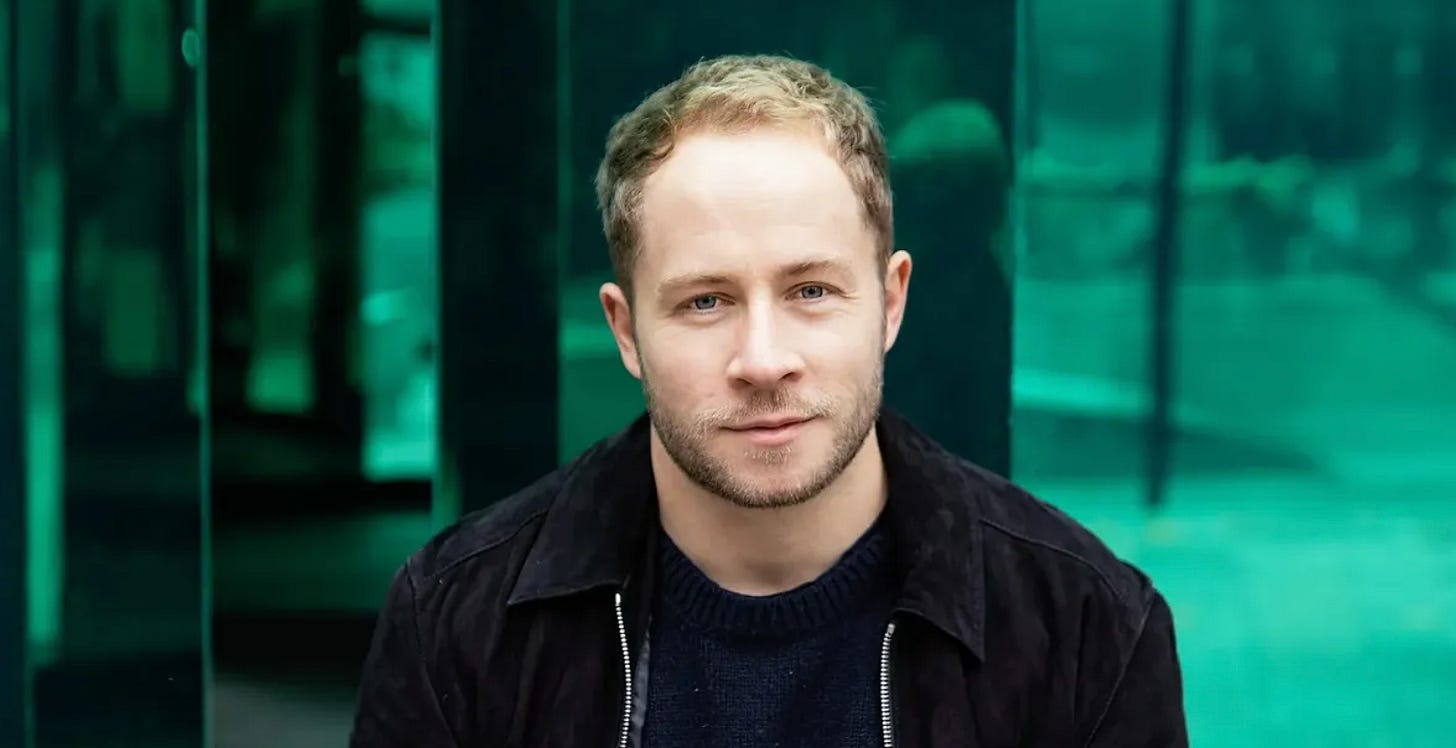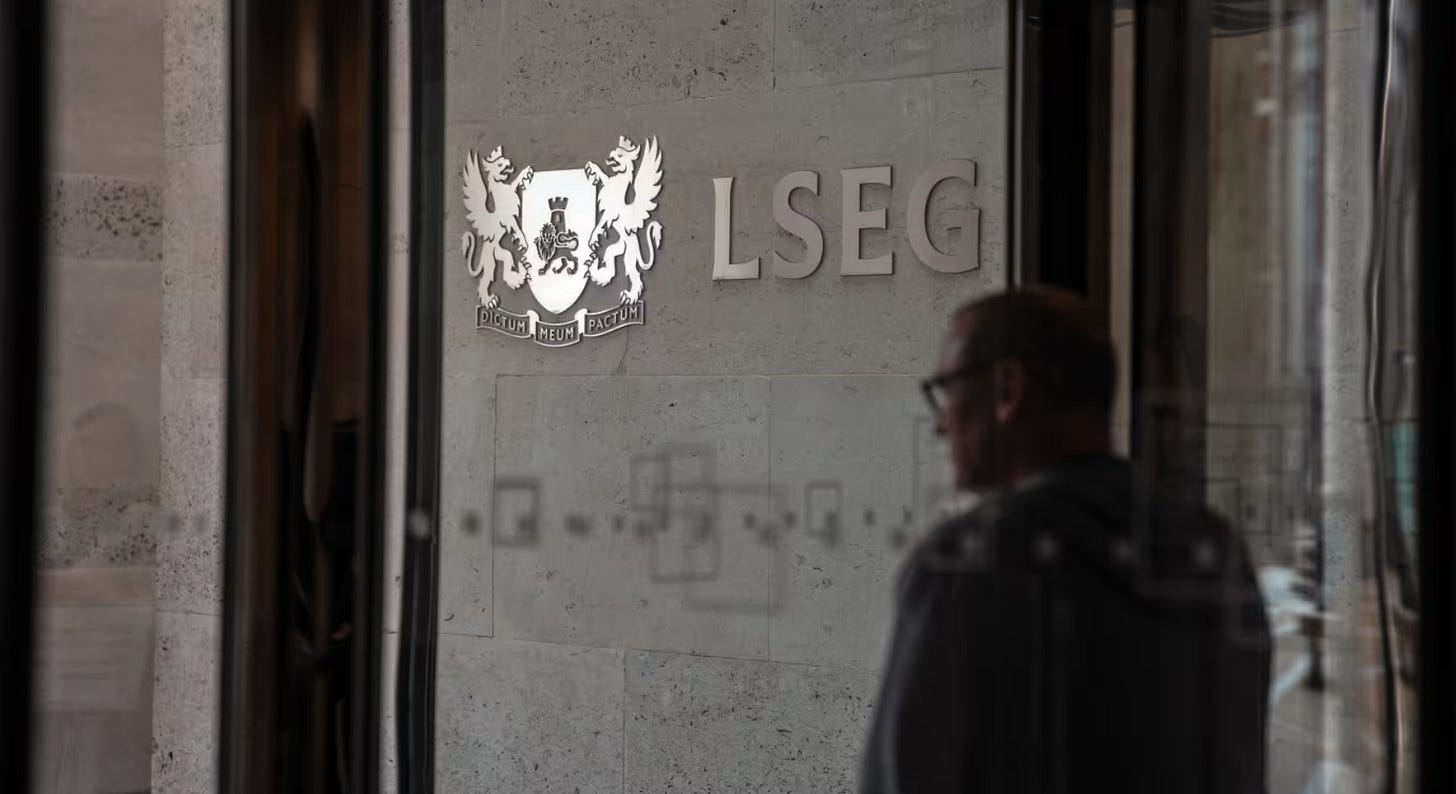Out with the old
When the nature of your business shifts fundamentally, your brand should too.
Issue № 142 | London, Sunday 28 September 2025
Read on to learn why:
① Brands must balance respect for their roots with a forward-looking approach.
② The job of brand assets is to convey your purpose to your stakeholders.
③ Without bold reform, the UK may be destined to be an incubator economy.
④ The artificial intelligence sector is starting to look like an Ouroboros.
⑤ Marketers have a lot to learn from great journalists.
⑥ Poor leaders may deliver performance but they’ll never build a great company.
⑦ Storytelling is a superpower.
✈️ But first, to those of you reading this on the plane to Frankfurt for Sibos, I salute you. Having done more of them than I can count, I know what an exhausting but ultimately rewarding week you have ahead of you. Once you’ve finished with IMTW, I recommend this piece from my friend Andrew Marshall on how banks can keep ahead in the transaction banking marketing marathon. Bon courage, mes amis!
What's new
LSEG has dropped London Stock Exchange imagery from its group website, Financial News reports.
In short:
“Earlier this month, LSEG changed its logo across the company’s website to remove a blue coat of arms resembling that of the London Stock Exchange as well as the bourse’s motto ‘dictum meum pactum’, Latin for ‘my word is my bond’. Instead, the new design features solely LSEG’s initials with no emblem. […] The LSE’s coat of arms and motto still appear on the exchange’s dedicated website, where it is referred to as ‘An LSEG business’.”
“Since acquiring data and analytics firm Refinitiv for $27bn in 2021, equities trading has become a significantly smaller part of LSEG’s business. The group’s data and analytics division has grown to comprise almost half of its revenue. Meanwhile, its equities unit — which includes the LSE — makes up less than 5%. Under American chief executive David Schwimmer, who joined from Goldman Sachs in 2018, LSEG has transformed into a more global company with around 27,000 staff across 65 countries.”
“LSEG has already shifted its marketing to reflect its broader international presence and additional business lines over the last few years. In a promotional video from 2023, an American-accented narrator quips that a more accurate name for the firm would be ‘The-London-and-every-other-place-in-the-world-stocks-bonds-currency-data-analytics-indices-risk-management-clearing-exchange-multi-asset-class-group’. […] Stephen Yiu, fund manager at LSEG investor Blue Whale, told FN in January that the group should rebrand to reflect its transformation into a technology business.”
Why it matters
About a year ago, when Scottish Windows planned to euthanise its old widow in a brand refresh, I told you that a distinctive brand asset is invaluable. It should be rejuvenated, never jettisoned. That was true then, it’s true now. But this story matters because it illustrates an exception to that rule: when the nature of your business, the very core of your value proposition, has shifted fundamentally, your brand should too.
① I met LSEG’s CMO about six months ago and remarked to her what a fascinating challenge it must be that only the ‘G’ in the brand’s name was still representative of its business. She smiled, well aware she needed to balance respect for the brand’s roots with a forward-looking, momentum-building approach. As Gustav Mahler is quoted as saying:
“Tradition is not the worship of ashes, but the preservation of fire.”
With that in mind, LSEG’s approach strikes me as eminently sensible. The company now employs 27,000 staff across 65 countries. Its brand needs to represent a global data and analytics business, more akin to a technology firm than an old bourse. It is wisely choosing to lean on its roots when that's appropriate but focus on positioning itself for the future.
What to do about it
Take action
② Your brand assets - whether that be your logo, your tagline, your colours, your fonts, your visual devices - should reflect your core principles and your brand’s DNA. Most importantly, they should help convey your purpose to your stakeholders.
Should your purpose change, should the nature of your business and the value proposition you offer clients transform, it makes sense to audit your brand assets to check they’re still doing their job for you.
Get help
Two ways I can help you: 1) hire me as a full-time member of your team; or 2) use InMarketing, an advisory service for senior leadership teams in finance and tech.
🔎 Audit 🧭 Strategy 🖋️ Positioning ✅ Planning 🤷🏻 Problem-solving ☎️ Counsel
Top stories
The other articles that are worthy of your time.
FINANCIAL SERVICES
Merge London Stock Exchange and Nasdaq to save City market, says fintech boss
③ Without bold reform, the UK may be destined to be an incubator economy.

“The boss of a UK-born fintech unicorn has called for the London Stock Exchange to merge with New York’s Nasdaq in a bid to save the City market’s future prospects.”
“‘The UK is only ever going to have finite capital, it’s the sixth biggest economy in the world, but it’s finite,’ said Barney Hussey-Yeo, founder of AI fintech Cleo. To solve this, he proposed a ‘pan UK-American stock exchange’ which he said would ‘dramatically change the depth of capital and listing prospects’ of UK and US companies.”
“He said the new task force created by Rachel Reeves and US Treasury Secretary Scott Bessent offered an ‘opportunity to do two major things’ to impact economic growth. The first, he said, would be a capital markets merger whilst the second could allow firms to ‘instantly passport’ across the nations with bold regulatory reform.”
TECHNOLOGY
Nvidia’s $100bn bet on OpenAI raises plenty of questions
④ The artificial intelligence sector is starting to look like an Ouroboros.

“One thing is clear about the announcement on September 22nd that Nvidia may invest up to $100bn in OpenAI in order to help the maker of ChatGPT buy 4m-5m of Nvidia’s artificial-intelligence chips. Silicon Valley is becoming more incestuous than ever.”
“Some Nvidia bulls celebrated the proposed investment as an expedient way for the chipmaker to fund sales. In effect, […] Nvidia would invest $10bn for every $35bn of GPUs that OpenAI buys, meaning OpenAI will pay 71% in cash and 29% in shares. But some expressed concerns. […] Stacy Rasgon of Bernstein acknowledged that the deal would exacerbate worries about the ‘circular dynamics’ of Nvidia investing in companies that it supplies with GPUs. Its size will ‘clearly start to raise some questions’, he said.”
“When announcing his agreement with Nvidia, Mr Altman laid out three priorities. One was pushing the frontiers of ai research. The second was building products that entice users. The third was the ‘unprecedented infrastructure challenge’, such as obtaining chips and power supply. A lot of interconnected wealth is riding on the hope that he can solve all three challenges simultaneously. None is proving as easy as getting his well-heeled friends in Silicon Valley to believe his promises.”
MEDIA & MARKETING
The journalist’s A-Z: What actually matters in the digital news game
⑤ Marketers have a lot to learn from great journalists.
“B – Branded content: Native advertising that walks the fine line between editorial integrity and paying your salary. When executed well, it’s storytelling that happens to serve commercial interests. When done poorly, it’s journalism’s reputation in a shallow grave. The key is transparency, editorial standards, and remembering that trust, once lost, doesn’t return with the next media spend.”
“H – Hook strategy: Advanced headline craft that goes beyond ‘Council Meeting Discusses Bins.’ Modern hooks create curiosity gaps, emotional investment, and clear value propositions. Study which openings drive engagement versus which generate clicks that immediately bounce. The goal is readers who actually read and appreciate your stories.”
“S – Smart Brevity: Axios-pioneered writing that respects readers’ time whilst delivering complete information. Strategic use of bullet points, bolded key phrases, and structured information flow. Every word earns its place, every sentence serves a purpose, and every paragraph advances understanding. Concision as craft, not just convenience.”
WILDCARD
When your CEO’s leadership creates chaos
⑥ Poor leaders may deliver performance but they’ll never build a great company.
“The signs are easy to spot: Talent drains. Innovation stalls. Psychological safety disappears. Yet boards often overlook these red flags if financial results remain strong. That leaves senior leaders with a difficult dilemma: How do I protect my team, keep the business on track, and influence upward when the CEO’s style seems immovable?”
“Consider ‘Alex,’ a chief marketing officer at a midsized technology company we worked with. Her CEO was celebrated for his brilliant vision but was also notorious for his impatience and intolerance of dissent. In executive meetings, he dismissed ideas that didn’t match his instincts, demanded instant execution, and cut people off mid-sentence. Directors began leaving. Engagement surveys flagged low trust, but the board’s metrics were narrowly focused on quarterly growth. As long as revenue continued to climb, the CEO faced little pushback.”
“Here are five strategies:
Manage up with intention: Managing up is not about appeasement; it’s about alignment. Start by asking: What outcomes matter most to my CEO?
Build agreements on communication and roles: Fast-moving CEOs often create organisational whiplash by revisiting decisions or overruling execution midstream. Ambiguity fuels frustration. The antidote is building explicit agreements, which reduces micromanagement while preserving momentum.
Amplify external voices: CEOs may dismiss internal dissent, but they rarely ignore clients, investors, or board members.
Form a coalition with peers: A lone voice of dissent is easy to ignore. A united leadership team is not.
Practice strategic patience: With visionary or founder CEOs, change is rarely immediate. Progress happens in layers.”
Off cuts
The stories that almost made this week’s newsletter.
FINANCIAL SERVICES
👋 Goldman’s listed private fund consciously uncouples from public markets
💰 Is Revolut really worth $75bn?
💪🏻 HSBC UK beefs up wealth arm with ‘generational’ bet
TECHNOLOGY
🇪🇺 ECB pushes forward with digital euro as launch timeline revealed
🪙 European banks join forces to launch euro stablecoin
😭 UK fintechs send rallying cry as industry slips in global ranking
MEDIA & MARKETING
😏 Saxo Bank’s marketing team gets slightly cheeky
🐦⬛ Stalling Starling revs up Engine in rebrand
📊 LinkedIn will integrate more data from Microsoft for ad performance tracking
The last word
⑦ Mike LeGassick on the power of clear, human communication:

“Storytelling isn’t a ‘soft skill’ — it’s the cornerstone of trust and understanding. When clients truly grasp the why behind their plan, they are far more likely to stick with it through the ups and downs.”
Don’t settle for marketing.
Aspire to InMarketing.
Wishing you an innovative week,







